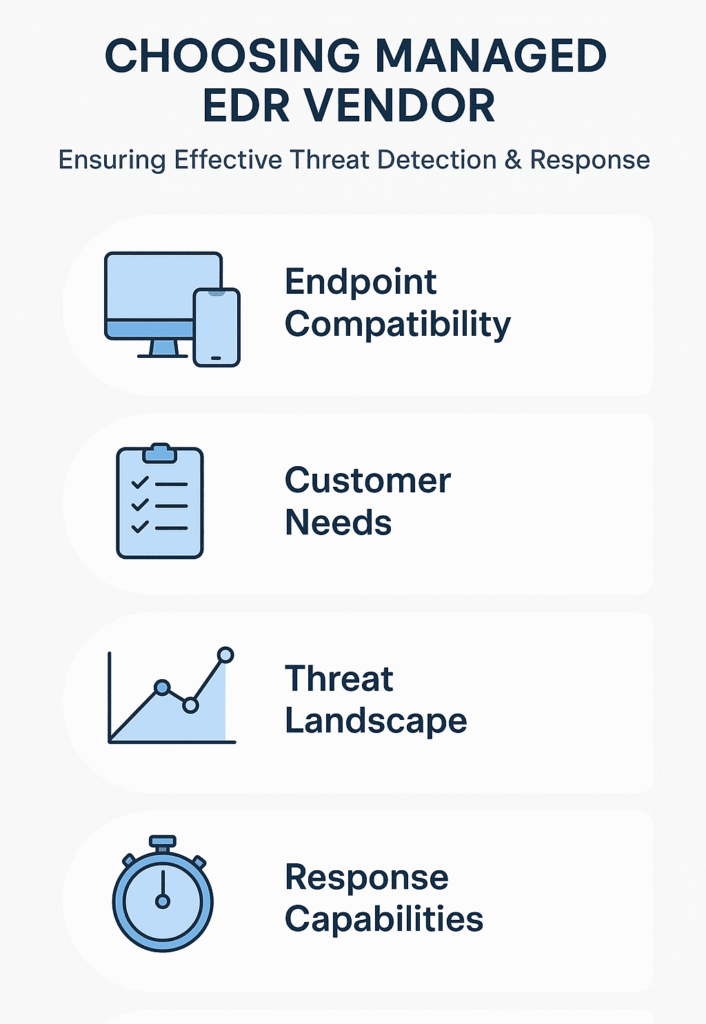Address
304 North Cardinal St.
Dorchester Center, MA 02124
Work Hours
Monday to Friday: 7AM - 7PM
Weekend: 10AM - 5PM
Address
304 North Cardinal St.
Dorchester Center, MA 02124
Work Hours
Monday to Friday: 7AM - 7PM
Weekend: 10AM - 5PM

Picking an EDR vendor comes down to round the clock protection that won’t break the bank. The best ones have real analysts watching for threats, not just algorithms doing guesswork.
They’ll spot ransomware and insider threats before they spread, and they won’t leave you hanging with a chatbot when you need help at 3 AM.
While fancy features look good on paper, what matters is having someone who knows the compliance maze and can actually pick up the phone. Want to know what separates the real deal from the wannabes? Keep reading.

There’s something fascinating about watching these EDR solutions evolve , they’re getting smarter by the day. When picking a managed EDR vendor, you’ve got to look at what they’re actually bringing to the table, not just their fancy marketing talk.
Let’s be real , if your endpoint detection and response setup can’t catch basic malware, it’s not worth the server space it’s running on. A decent vendor’s going to offer:
The days of just matching virus signatures are dead and buried. Any vendor worth their salt’s gonna have machine learning baked in, it’s not perfect, but it’s better than crossing your fingers and hoping for the best (only 48% of security professionals say they feel confident their org can execute an AI-in-security strategy, so adoption is real but uneven) (1).
They should offer:
Security teams need to see what’s happening right now, not tomorrow. A solid vendor shows you:
Those monthly reports better tell a story that both the tech team and management can understand , cause if they don’t, what’s the point?

Credit: pexels.com (Photo by Mikhail Nilov)
There’s more to endpoint security than fancy tech specs and marketing promises. A vendor’s operational backbone might just make or break your security posture.
The SOC setup comes in three flavors, each with its own quirks:
Security never sleeps, and neither should your vendor. Round the clock platform monitoring isn’t just nice to have anymore , it’s pretty much non negotiable. Those 3 AM alerts won’t wait till morning coffee.
When something’s fishy in your network, every minute counts. The best vendors promise to jump on issues in under 15 minutes , and actually deliver on that promise. Their support team should speak your language (both technically and literally), and know your setup inside out.
Every minute of downtime can cost a data center $8,000, and some incidents cost a whopping $630,000, so fast vendor response isn’t just nice, it’s vital (2).
A vendor’s track record speaks volumes. Those fancy certifications on their wall? They matter. But what matters more is their real world experience handling incidents like yours. Some vendors might be great globally but stumble on local support , something to think about.
Anyone who’s spent time picking an EDR vendor knows it’s not just about fancy features and blinking lights. The real challenge?
Navigating through a maze of business requirements, compliance rules, and local quirks. Here’s what really matters when you’re sizing up EDR vendors.
Let’s face it , regulations aren’t going away. Companies can’t just pick an EDR vendor and hope for the best anymore. Between GDPR’s strict data rules and HIPAA’s demands (which keep getting tougher), there’s a lot at stake. The vendor’s got to know these rules inside and out, or you’re asking for trouble.
Time zones matter a lot. When malware hits at 3 AM local time, you don’t want to hear crickets from your vendor’s support team. And it’s not just about being awake , they need to understand what’s happening in your backyard. Regional threats aren’t the same everywhere, and cookie cutter solutions don’t cut it.
The pricing game can get messy. Some vendors charge by device, others by user, and the math isn’t always straightforward. A deal that looks great at 500 endpoints might become a budget,buster at 5,000. Better to do the math upfront than face an awkward conversation with the CFO later.
Sure, Windows machines are everywhere, but that’s not the whole story. Your vendor needs to handle everything , those stubborn Linux servers, the design team’s Macs, and yes, even those smart coffee makers in the break room (they’re endpoints too, believe it or not).
Some companies want their security on autopilot, others like to keep their hands on the wheel. Neither’s wrong, but your vendor needs to match your style. And if you’re planning to double in size next year? Make sure your vendor can keep up without doubling your headaches.
The threat landscape’s changing faster than ever. Yesterday’s ransomware is old news, and tomorrow’s threats probably haven’t been invented yet. Your vendor needs to be quick on their feet , watching for threats 24/7 and ready to jump when something looks off.
Time’s running out the moment malware hits a system. Those first 60 minutes after detecting ransomware or a phishing attack make all the difference, and there’s no room for delayed decisions or waiting around for morning meetings.
Nobody wants security teams wasting hours chasing down every single alert (and there might be thousands per day). Smart automation in endpoint threat detection and response takes care of the obvious stuff, letting analysts focus on real problems that need human eyes.
Security teams can’t just sit around waiting for attacks anymore. They need fresh intel from everywhere , Europe, Asia, the Americas , right as threats pop up. The best security companies have people working 24/7, digging through the internet’s darker corners to spot trouble before it spreads.
A fancy EDR system’s pretty much useless if it can’t play nice with everything else. Think of it like this: when something bad happens, you need all your security tools talking to each other, not sitting in their own little worlds.
There’s nothing worse than security tools that don’t mesh with what’s already there. When something suspicious shows up, every part of the system needs to work together , kind of like a well,oiled machine, but for cybersecurity.
The extra stuff that actually matters:
Walk through any security conference and you’ll see at least 50 EDR vendors, all claiming they’re the best thing since sliced bread. Skip the flashy demos and free t-shirts. What matters is how well they’ll protect your network when things get real.
Think of this like a pre, flight checklist (because honestly, that’s what it is):
This isn’t like picking a new coffee maker for the break room. Your EDR partner’s gonna be there when things get rough (and they will get rough). Map out what you’ve got now, every device, every weird legacy system that marketing won’t let you kill off. Then get some demos going.
Don’t be shy about asking uncomfortable questions. How fast can they really respond at 3 AM? What’s gonna happen to that price in year two? The time you spend being picky now might just save your network later.
Remember, the best partner isn’t always the one with the shiniest features or the biggest market share. It’s the one that fits your actual needs, not the ones you think you might have someday.
We offer expert consulting tailored for MSSPs to help streamline operations, reduce tool sprawl, and boost service quality. From vendor-neutral product selection and auditing to stack optimization and decision.
Support resources, we guide you in choosing the right tools, improving integration, and enhancing visibility.
With over 15 years of experience and 48K+ projects completed, our services include needs analysis, vendor shortlisting, PoC support, and clear, actionable recommendations, so you can build a tech stack that aligns with your business goals and operational maturity.
Start building the right partnership today
When evaluating EDR vendor selection, think about how the managed detection and response service fits into your IT setup. Ask if the vendor offers endpoint protection, malware detection, and advanced threat detection.
A managed detection and response (MDR provider) often combines threat hunting, security operations center expertise, and proactive security with automation. Traditional managed cybersecurity services might focus more on prevention tools.
Vendor reputation, vendor experience, and client testimonials give insight into how reliable a managed EDR vendor is. A trusted cybersecurity vendor should demonstrate proven cybersecurity expertise, compliance support, and regulatory compliance knowledge.
Security platform management is key when choosing a managed detection and response service. Ask about centralized management, security reporting, and endpoint visibility. Find out if they support endpoint sensor deployment and security policy customization.